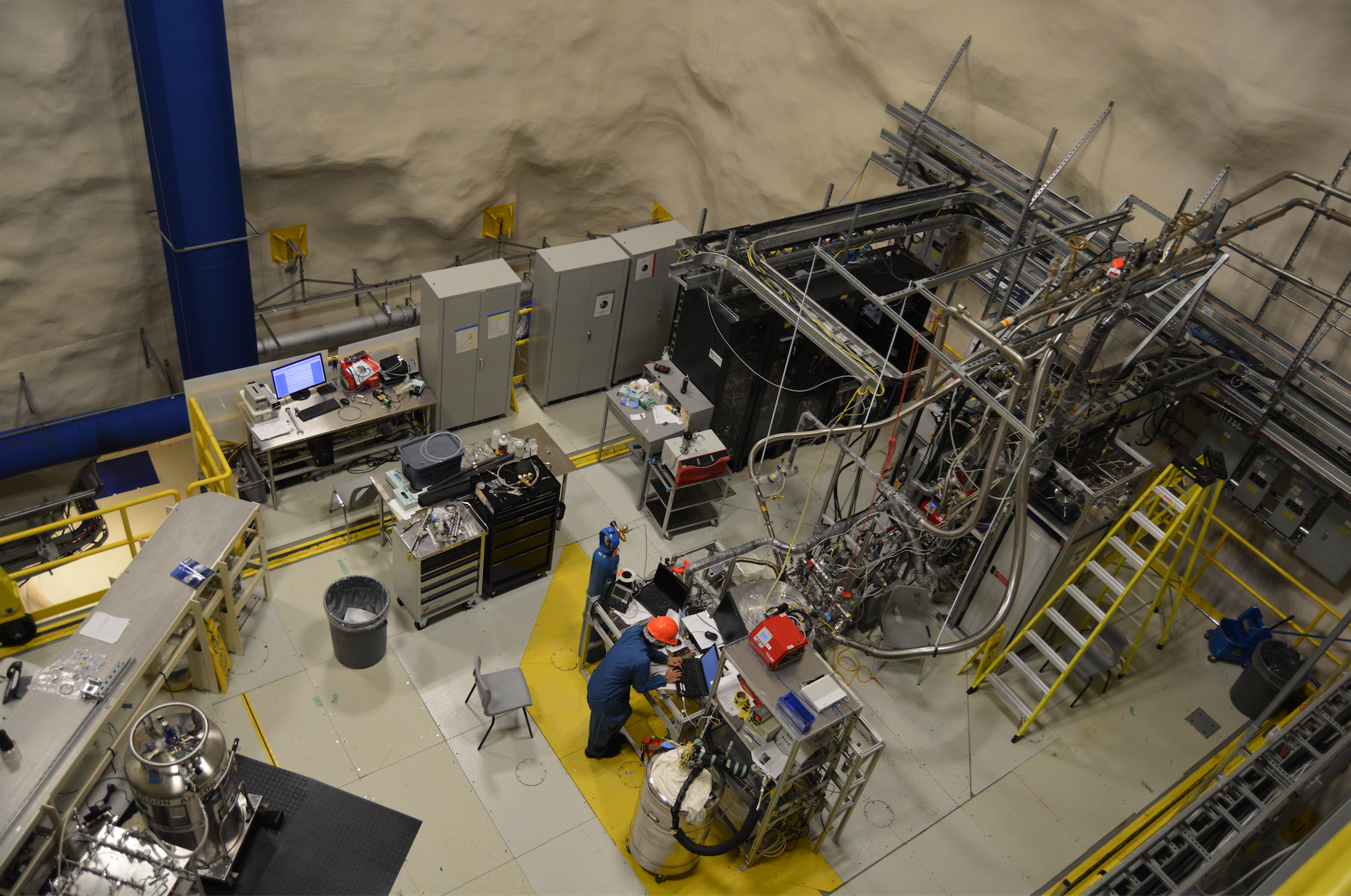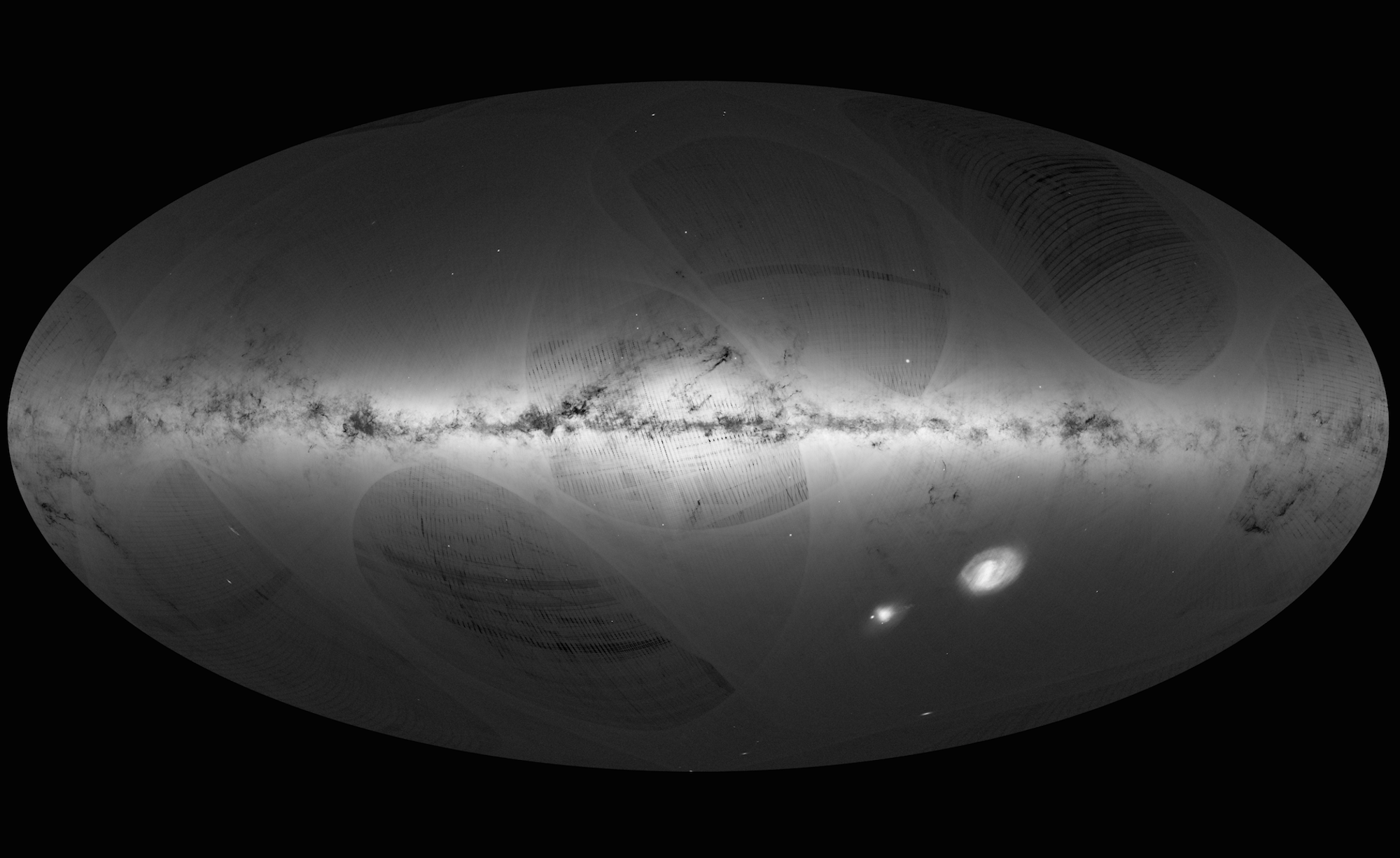It can be unsettling to realize that only five percent of the universe is made of the kind of matter we know and understand—everything from the planets and stars, to trees and animals and your dining room table.
Roughly one-quarter is dark matter. This is thought to knit the galaxies together, and has been called the “scaffolding” of the universe, but we’ve never detected it directly. Scientists believe they can see dark matter’s traces in the way that galaxies rotate, but they still have no idea what it is. (Most of the universe, about 70 percent, is dark energy, a mysterious force that permeates space and time. It’s even less well-understood than dark matter.)
Videos by VICE
Confirming dark matter’s existence would change humankind’s perspective on the universe. 2016 was a year of dark matter disappointments, as big searches came up empty. Most are looking for WIMPs—weakly interacting massive particles, the leading contender for a dark matter particle.

Image: Ben Ruby
2017 might just be the year we finally catch one. And if we don’t, well, it may be that our best theories about dark matter are wrong—that we’re looking in the wrong places, with the wrong instruments. Maybe dark matter, whatever it is, will turn out to be even weirder and more surprising than anyone has so far predicted. Maybe it’s not a WIMP, but some other bizarre kind of particle.
Then there’s the outside possibility that dark matter doesn’t exist, that it’s an illusion. If that’s the case, we’ll have to consider whether we’ve been fundamentally misreading the universe’s clues.
*
Buried deep in a mine near Sudbury in northern Ontario is SNOLAB, a vast underground laboratory where scientists are performing a range of experiments, including looking for dark matter. Often compared to the lair of a Bond villain, it’s an ultra-clean, high-tech facility. Two kilometers of solid rock overhead shield its detectors from cosmic radiation, allowing them to sift for bits of matter from dying stars and the Sun: science done here won the Nobel Prize in Physics, in 2015.

A scientist works on the deck of DEAP-3600, a dark matter search at SNOLAB. Image: SNOLAB
I recently travelled to SNOLAB. To get there, I had to don full mining gear (including a hardhat and headlamp), drop down underground in a rattling dark cage, and hike a kilometre or so to reach the gleaming white facility, which is cleaner inside than an operating room—a startling contrast to the dirty nickel mine that surrounds it.
After the long hike through the mine, anyone who wants to enter SNOLAB has to undress, shower (with soap and shampoo), and put on lint-free clothing and a hairnet. Any bit of dust from the mine, which is naturally radioactive, can mess up the experiments.
There, I met research scientist Ken Clark, a congenial physicist with a sandy-coloured beard. Like me, he was wearing safety goggles and a hardhat. Clark has worked on high-profile dark matter searches like CDMS and LUX, and collaborates on the IceCube detector at the South Pole in Antarctica. Now he’s with PICO, a dark matter search that targets the WIMP particle. It was launched in 2013 when two other collaborations, called PICASSO and COUPP, merged.

A multi-bubble image of a neutron scattering in the PICO detector. Image: PICO Collaboration
PICO is a bubble detector: a tank of superheated fluid kept higher than its natural boiling point. If dark matter bumps into the nucleus of another particle in the detector, it should cause a tiny bubble to form. Dark matter courses through the Earth and right through our bodies, so it will reach the detector underground, even through all that rock overhead. But that’s also part of the challenge—dark matter is thought to only rarely interact with normal matter, if at all, so it’s really tricky to catch.
Clark believes we might just find dark matter in the next year or two. “It’s exciting times,” he said.
Other searches are due to turn on soon, he explained, and those that are already up-and-working are getting increasingly sensitive. In 2017, Clark said it’s possible we’ll see new results from PICO, DEAP (a different detector, also at SNOLAB), as well as China’s ambitious PandaX project, and another in Italy called XENON1T. Even more searches will turn on in 2018.
“Provided the models are correct, we should see something soon,” Clark told me.

A scientist works on the steel vessel of DEAP-3600. Image: DEAP Collaboration
Still, there’s no guarantee, and WIMP searches keep turning up empty-handed. For example, in the summer, the highly sensitive LUX—which uses liquid xenon in a South Dakota mine as its detector—announced it had seen zero WIMPs, after looking for more than a year.
Read More: Dark Matter Pioneer Vera Rubin Has Died
I phoned Lisa Randall, a prominent theoretical physicist and professor at Harvard University, to ask whether she thinks there’s a chance we’ll find dark matter in the next year or two.
“I would say kind of the opposite,” said Randall, author of Dark Matter and the Dinosaurs. While she agrees that if dark matter is indeed a WIMP, these searches could find it soon, “that’s just one possibility,” she said.
The WIMP is “lowest-hanging fruit,” Randall continued: this theoretical particle fits snugly within what’s already known about the Standard Model of physics, which explains how the building blocks of the universe interact. And scientists can imagine ways to actually look for WIMPs, unlike some of the more far-out theories, which are much harder to test in experiments.

GIF: Ben Ruby
“What if it’s not a WIMP?” Randall said. “Could we still learn something about what dark matter is?”
*
Other scientists have different strategies for solving the dark matter puzzle.
Leslie Rosenberg, a professor of physics at the University of Washington in Seattle, is project scientist on the Axion Dark Matter Experiment, or ADMX, which is looking for a theoretical particle called the axion, which is thought to be much lighter than a WIMP. It’s being targeted by other searches under development around the world, Rosenberg told me. ADMX, though, is “the only high-sensitivity axion search now,” he said.
Maybe we’re being fooled into thinking that dark matter is there
ADMX, which uses a resonant microwave cavity nested inside a huge superconducting magnet, started out of a collaboration that began in the mid-nineties. It’s been at full sensitivity for about a year now, Rosenberg told me, and will only get better as the team continues to tweak it. He’s hoping they turn up something soon: their next update should come in the summer of 2017.
“Axions are bound up in our galaxy,” Rosenberg said. “There [should be] an awful lot of them, and we depend on that as the source of our signal.”
Axions are a mainstream dark matter candidate. Other ideas get weirder.
“Personally, I’m interested in the idea that dark matter might have nothing to do with the Standard Model,” Randall told me. “One of the possibilities is that it could be some other type of particle. Maybe it interacts [with itself] via its own light, a dark photon.”

Gaia’s first sky map of the Milky Way, based on data collected from July 2014 to Sept. 2015. Image: ESA/Gaia/DPAC
Randall thinks that one of the best ways to learn about dark matter may be to study the structure of galaxies, and watching the universe at work, to understand how it interacts with itself. The European Space Agency’s Gaia mission, which is making a three-dimensional map of over a thousand million stars, could give insight into some of this, Randall said.
Asimina Arvanitaki, a theoretical physicist at the Perimeter Institute for Theoretical Physics, suggested to me in a Skype call that dark matter might be detectable through resonant-mass detectors, which are used to hunt for gravitational waves. These ripples in spacetime were detected for the first time in 2016, a hundred years after Albert Einstein predicted their existence.
Dark matter could also be behaving like a wave, “trapped by gravity and oscillat[ing] at a frequency set by the mass,” she said.
“The funny thing is you could perhaps even hear dark matter,” Arvanitaki said, “depending on the frequency.”
*
Over millions of years, humans have come up with ingenious ways to probe the world around us, from Copernicus and Kepler, through the thousands of scientists involved in the search for the Higgs boson particle at the Large Hadron Collider, and those who are now shaking out the endless diversity of exoplanets that populate our galaxy.
Because of them, our perspective has changed. When we look up at the night sky today, we understand that just about every star we see hosts at least one planet. The first confirmed exoplanet was announced just over two decades ago.
Nature can still surprise us.

The Bullet cluster, formed by the collision of two large galaxy clusters, provides some of the best evidence yet for dark matter. Image: X-ray: NASA/CXC/CfA/M.Markevitch et al.; Optical: NASA/STScI; Magellan/U.Arizona/D.Clowe et al.; Lensing Map: NASA/STScI; ESO WFI; Magellan/U.Arizona/D.Clowe et al.
“There’s a chance that dark matter isn’t necessarily a particle at all,” Clark told me. “Some [theorists] say there’s no dark matter. It’s just that we don’t understand how gravity works at large scales,” he continued. “If that’s the case, we’re being fooled into thinking that dark matter is there.”
Clark and the other dark matter hunters continue their search. If it’s real, “we’re not even made of what most of the universe is made of,” Rosenberg told me. In the grand scheme of things, then, it isn’t dark matter that’s really so exotic and strange—it’s us.
Get six of our favorite Motherboard stories every day by signing up for our newsletter.




